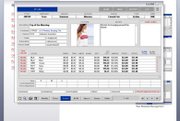Tapping Into Tech With ApparelMagic's John Murphy
The business side of the apparel business— fulfilling orders, tracking materials and inventory, and handling processes such as EDI—is an area often overlooked by start-up companies and new designers who are more concerned about the creative side of their businesses. However, emerging software technology is making it easier for anyone to handle the mass of paperwork involved in running a company.
John Murphy, founder of Glendale, Calif.–based Murphy & Associates, created ApparelMagic software to help companies manage sourcing, order processing, customer management, EDI integration, accounting and financials. The company was founded in 1984 and has compiled an impressive list of clients, many from California. Among the company’s newest clients are Affliction Clothing, Lejon Tulliani, Alexander Wang, Industry Rag, Bishop of Seventh and Steve Martino & Associates, according to Murphy.
Murphy has endured the hills and valleys associated with the software industry as well as the apparel industry. The company’s product is one of the few geared especially for the apparel industry. Murphy met with California Apparel News Technology Editor Robert McAllister to discuss how apparel companies can benefit from technology.
In the apparel industry, software is kind of an unsexy subject in a sexy industry. How receptive or unreceptive is the industry to using software to help streamline its operations?
JM: Software is unsexy compared to runway models. But to a production manager with deadlines to meet or a designer whose notebooks are overflowing, software has an allure all its own. The key is in finding out what the customer’s needs are and then presenting the side of your software that will help. It does no good to try to dazzle the user with features that aren’t relevant to his or her needs. Of course, you can help to educate the customer about other benefits you feel are relevant.
California has a lot of small companies, from garage-type start-ups that can grow fairly quickly to companies with business plans and substantial seed money. When do you recommend using software to help companies manage orders, shipping and beyond? Is something such as QuickBooks and Excel sufficient to run a smaller company?
JM: How much time is a small company spending on building and maintaining their spreadsheets and updating figures between Excel and QuickBooks? If it’s significant, we ask them to consider whether an integrated package would save them time and money. There are other qualitative benefits of having the data all in one place, related to efficiency and competitiveness. When small companies can call up their customers’ histories, buying patterns and technical details quickly within a single system, that means they can give better customer service and create opportunities for increasing sales and improving relationships.
ApparelMagic has an impressive list of clients, especially from California. You’ve been around for a while, outliving the technology busts and booms. What is your strength? In what ways can you help companies grow their businesses?
JM: ApparelMagic grew up in California, and for almost a quarter of a century we’ve been trying to do three things well: give users software that’s a pleasure to use and works well, provide high-quality technical support and training, and evolve with the changing needs of the industry.
One of our strengths is that we spend so much time on our look and feel and our system integration. We constantly test the software to make it easier to do things, perform with fewer clicks, link to more third-party systems and provide more relevant reports. We obsess about these things.
Another advantage is the adaptability of our software. ApparelMagic is an open system that can talk to a broad range of related products and services via our Web, SQL and PHP interfaces. We provide a complete tool set for Webmasters who want to link their e-commerce sites or outside warehouse to ApparelMagic.
The most powerful tool we have for helping clients grow is not our product but our knowledge. We’re very proud of ApparelMagic. But we’re even prouder of our industry knowledge and our ability to help a client get the most out of our software.
The department-store business has consolidated a lot in recent years. Has that affected compliance issues such as EDI (electronic data interchange) very much? Do even the smaller companies need to have EDI now?
JM: EDI is more relevant than ever to small suppliers. We’ve seen some of our smaller clients go from product introduction to department-store demand in just a few months. And with those department-store orders comes the need for EDI compliance. Fortunately, the technology today allows ERP systems like ours to link effectively to many EDI partners. However, a very important part of the solution is to make it easy for the end-user to set up. For example, ApparelMagic manages the UPC codes for the product catalog and provides an open map for importing and exporting EDI transactions. We also work directly with the industry’s leading solution providers like 1 EDI Source and DI Central.
Obviously, a lot of manufacturing has moved overseas. How has that affected operations for U.S.-based companies, and how can software help this changing model?
We see more importing and distributing today than ever. Many of our U.S.-based clients have suppliers or partners overseas. Of course, the motivation is increased profitability, but it also implies that your information must be updated by several sources, not all ’in house.’ We discuss options with our clients regarding how they will deploy ApparelMagic. Do their contractors need Internet access? How will WIP and shipping status be maintained? Who will participate? These are not just software questions but human-resource and process questions.
Has ApparelMagic been working on any new improvements or applications that you can tell us about now?
JM: The ApparelMagic accounting module will be updated next month with a brand-new user interface and expanded reporting and analysis tools. Version 10.2 of the ApparelMagic point-of-sale module is in beta testing and will be released at the end of the year. We’re developing new OS Commerce and Zen Cart templates for clients who want easy choices for linking their Web stores with ApparelMagic.
Where do you see the apparel industry heading? Do you think design will continue to be strong here? Do you think the current business model will look very different in five years?
JM: California is a mecca for design and lifestyle brands. And it’s also a production powerhouse. But as the industry moves forward, branding, design, instant sourcing and distribution will be the new paradigm. Technology is a great equalizer for young aggressive companies who know how to use new media to create buzz. Large companies will still be able to exploit the advantages of mass purchasing. But the changes in the distribution chain allow smaller, adaptable companies to be very competitive. Just as with Internet radio and YouTube, the small ’content’ provider will leverage technology to compete where they have the advantages: innovation and speed.























